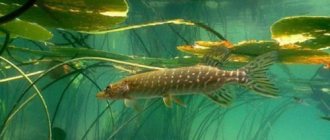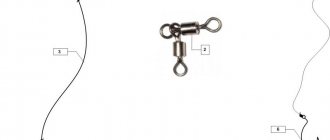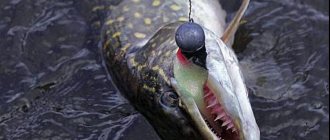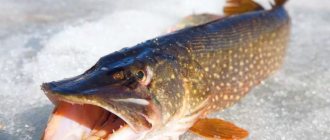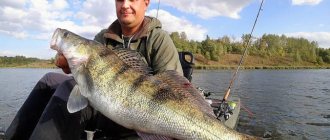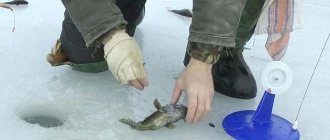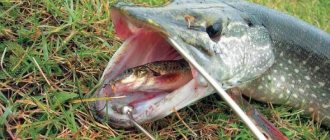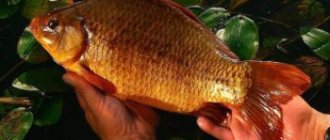To catch pike in February, the features of natural phenomena that directly affect the behavior of underwater inhabitants are taken into account. Fishing conditions are not comfortable – it’s deep winter. But in the middle to end of the month the situation begins to change. Outwardly it is not yet noticeable - frost, wind and thick ice. However, the fish senses the approach of spring. In preparation for spawning, it leaves its winter mooring sites.
Pike activity in February
Pike behave differently in different regions in February. In the North, this whole month is a harsh time, you need to focus on a passive predator, and catch according to the rules of pike in the wilderness. In the middle zone sometimes (if there is a warm winter and early spring), and in the south always, already from the middle of the month the February pike becomes more active. At this time, frequent thaws force the predator to leave its habitat and go out into shallow waters in search of food. The pike bite in February is unstable and depends on many factors:
- Time (beginning of the month or end), depending on the region.
- Migrations of forage fish.
- Oxygen saturation of water.
- Moon phases and weather.
- Internal specific feeding rhythms in this particular body of water.
There may be many reasons why pike do not bite in February. No catch today - tomorrow it could be different. Favorable days for pike fishing in February are determined only theoretically - these are thaws and periods of smooth weather without sudden changes. In practice, you can get to the exit of a predator even in terrible bad weather, blizzards and frost. In some reservoirs, the toothy fish is inactive, in others, pre-spawning migrations and even feeding begin at the end of the month.
Fishing sequence
When fishing for pike in February, a fairly effective and simple fishing technique is used, consisting of finding a place, drilling holes and catching them.
Fishing technique
- Search for a promising place - using a depth gauge or echo sounder, they find an area with great depth, a sharp drop (before the middle of the month), shallow areas, watering (at the end of the month).
- Drilling holes - holes are drilled in the selected area in increments of 10-15 meters. When drilling a hole, especially at a depth of up to 1 m, it is better not to “pump” it (clean it with sharp movements, lowering the ice pick into the drilled hole and pulling it out with an auger clogged with slush) - this will not only not create unnecessary noise, but will also obscure the hole.
- The order of fishing holes - fishing begins with the holes drilled first, 10-15 lifts are performed in each of them, and if there are no bites, they move to the next one. If a pike is caught in a hole, they mark it with a twig or branch and move on to the next one in order to return to it after a while - the place of the caught pike, as a rule, is taken by another.
Peculiarities
In February pike fishing there are several features characteristic of this month that must be remembered and, if possible, used when fishing:
- The pike bite until the middle - the beginning of the second ten days of the month is not very active - the predator feeds no more than half an hour a day, so it is very important to find out from local fishermen what time the toothy fish most often comes out to feed and place bets in advance or make holes and start catching them their artificial baits.
- We recommend small crucian carp as live bait at this time - unlike perch and roach, it remains alive longer and is not very susceptible to changes in atmospheric pressure.
- From the middle of the month, pike, preparing for spawning, begins to move from holes to shallow waters, where they feed longer and more actively, so in the second half of February the predator should be caught in the coastal zone, in shallow bays and backwaters.
- The universal places for predator fishing throughout February are the mouths of streams and rivers, places where springs gush out - in such places there is much more oxygen than in other parts of the reservoir, which attracts small fish, and after them pike.
Beginning of the month
Pike fishing in early February is almost everywhere no different from January fishing. This is mainly jig fishing with thin rigs or lures using small baits and sluggish play. The habits of pike in February can change at any time - depending on the vagaries of seasonality and weather. In some bodies of water, activity can gradually increase, while in others the zhor turns on abruptly, as if someone pressed a magic button. It all depends on the conditions of the reservoir and external atmospheric influences. Where to find pike in February, when it is passive? In the places where it was caught last month - deep edges, holes, thickets of underwater vegetation, flooded snags, entrances and exits from holes, boundaries of channel ditches. On some reservoirs, the toothy fish comes to nearby shallows. Article about winter fishing for pike:
Choosing the right weather
Of course, you need to go to the pond at a time when the pike is biting. Not when the weekend starts and not when you can ask your boss for a day off. As they say, if fishing interferes with work, then why do you need such work?
I still remember the end of February 2009. It’s been almost 6 years now, but I remember that winter fishing so clearly in the smallest detail.
Then, in the second ten days of February, part of our team went to a secret reservoir and began reconnaissance there. These three anglers were on vacation, and they could afford to go to the reservoir and explore the most hidden corners of the winter reservoir.
And we, four forced people, were left to sit our pants in the office and wait for news from our intelligence. And then on Tuesday evening we receive news that they are catching pike. Moreover, they catch, and do not search and do not torture. Pike bite on spinners, pike bite on balancers. Yes, she generally takes everything, and the guys were tired of dragging her out of the holes that day.
Wednesday and Thursday passed with the same news. Can you imagine our state on Thursday evening? Two of us were ready to submit applications of our own free will, just to get on the ice and start catching fat pike.
As a result, barely waiting for the end of the working day on Friday, our team hastily loaded into a combat fishing vehicle and quickly, quickly drove to those places where our reconnaissance group was fighting an unequal fight with the predator.
By nightfall we were there. It cannot be said that the satisfied faces of our fishing friends added to our mood. But we were ready for tomorrow’s drive – we were in a fighting mood.
End of February
The increase in day length, average daily temperatures and light levels at the beginning and end of the month vary significantly. It's heading towards spring. Therefore, in most reservoirs, although outwardly the weather does not yet smell like spring, the predator becomes active along with the rest of the fish. Developing eggs and milt require the supply of nutrients consumed over the winter. The pike, following the small fish, leaves the depths and begins to feed intensively. The winter Eldorado is coming for spinners and giraffes, which will gain maximum strength in March.
The behavior of pike in large reservoirs in February is different - it begins to wake up earlier. This is due to the fact that in large reservoirs, pike migrate in the spring to spawn in tributaries, covering long distances. And now, even though the reservoir is still covered with a meter-long layer of ice, she is beginning to prepare for this journey. Usually pike do not come in a continuous mass. At first, only a few individuals leave the pits for a short time. But every day these phenomena are intensifying. With the beginning of the melting of snow and ice, almost all the pike will already be in shallow waters in the coastal strip, near river mouths. On small rivers and closed ponds (lakes), you need to look for resident pike in the same place as always. Large reservoirs are distinguished by their specifics.
Where to look for pike at the end of February? More often these are coastal waters with shallow depths of up to 3 meters (usually 1-2 m) with thickets of last year’s dry reeds, reeds and cattails, estuary bays, areas near dams, dams, locks and other hydraulic structures. Depending on the region, travel times vary greatly. The fisherman needs to make inquiries specifically about his own body of water. Therefore, studying pike biting calendars in February or tables is useless. It is better to thoroughly study the features of the reservoir, check the information with local fishermen or on forums. On large bodies of water, you need to strategically determine in which area of the water area the pike is now. And this information will not be relevant for long - soon the predator will move on. However, some of the stock does not go far, spawning not far from their places, in the coastal strip. Therefore, you can always find a random resident individual, even if the main body of fish has disappeared.
Choosing a fishing spot
Since there is a gradual change in weather during February, the increase in day length and air temperature of the pike's stopping place at the beginning of the month and at the end differs.
From the beginning to mid-February, when there are still severe frosts at night and sometimes during the day, pike prefers to stay in the following places:
- deep holes and pools;
- deep edges;
- flooded snag;
- the mouths of streams and rivers that flow into a larger river, pond, or lake.
At the end of the month, as the sun begins to melt the ice and snow on the banks of reservoirs and life-giving oxygen begins to flow into the reservoir with melted streams, the pike, following the small fish, leaves the depths and begins to hunt in places such as:
- coastal strip with shallow depths of up to 2-2.5 and thickets of dry reed and sedge;
- places where streams and rivers flow into a lake or pond;
- areas near various hydraulic structures - locks, dams, dams.
Fishing methods
Let's look at how and what to catch pike in February. Fishing tactics, technique and equipment of gear are determined by the level of activity of the toothy fish. Winter fishing for pike in February can be very different, depending on whether it has a deep-winter hunting mode, or whether the toothy one has already woken up and started actively feeding. For a passive predator, you need the same gear and fishing methods that were used in the dead of winter - this is more delicate equipment, small baits and thin transparent leashes. The lure fishing technique needs to be sluggish and slow - for passive pike. For active fish, the usual rough tackle with metal leashes, the usual game and the whole range of baits for vertical trolling are used.
Zherlitsy
February fishing for predators using baits of various kinds is more common. Despite the increased activity, in most reservoirs the toothy fish prefers small baitfish (the cavity of the internal organs is occupied by eggs and swallowing large prey is problematic). And this is also a factor of increasing activity, because small fish need to be swallowed more in order to cover the need for nutrients. Catching pike with live bait in February is interesting and productive - the main thing is to find an active predator. About where to catch pike in February, what equipment to use on the girders - in a separate article:
https://podlednik.ru/lovlya_zimoj/zherlicy/shhuka-v-fevrale-flazhki
Spoons
We try to seduce passive fish, as in the middle of winter, with small spoons, using slow play and thin equipment. An active predator will attack a wider range of baits. The severity of the wilderness no longer weighs us down - we use the tactics, techniques and gear of classic winter fishing. Catching pike in February with lures is a popular travel fishing activity. For active fish, the more kilometers you walk and check promising places, the richer the catch. It is better to use small baits. You need to use and check different ones - you never know what will attract the toothy fish in this particular body of water. An article about winter lures for pike.
Crab spoon with bait
Ratlins
Rattlins (bladeless wobblers) are becoming more and more popular among winter roads, settling in the bait bags of an increasing number of spinners. For February pike, these baits are also worth using. Sometimes these decoys work when the spinners are silent. This type of bait requires the angler to master the playing technique. Each ratlin requires an approach, an individual game. Read more about winter pike fishing with ratlins.
Balancers
Of course, good old balancers also work. Catching pike in February with a balance beam also depends on the level of activity of the predator. At the beginning of the month it is better to use small baits, maybe even bladeless ones with a tassel or twister on the back hook. For active pike we use the entire range of baits and standard game. The technique of play and the choice of bait color depend on the conditions of the reservoir and the preferences of the predator. These features are revealed already on the ice during fishing. Read more about winter fishing for pike with balance beams.
Ice jig
Fishing with silicone or edible rubber from ice is becoming increasingly popular. The gear is used as for trolling - a durable flexible fishing rod, a reel, a leash of at least 20 centimeters. Game - tapping on the bottom or various options for vertical play. The weight of the sinker is selected depending on the conditions. An absolute advantage is the ability to fish in strong currents (using a heavy jig head) vertically or by pulling under the ice. This is useful if you manage to find active fish, for example, at the entrance to tributaries or going upstream on small rivers.
Conclusion
It’s difficult to catch a pike in the middle of nowhere; you need to clearly know where it’s staying and when it’s going to go out for a short hunt. To obtain such information, it is better to experimentally study the reservoir. Information received from local fishermen will also be relevant. A fairly important addition is the use of modern technologies: latest generation echo sounders, underwater video cameras that transmit information to the fisherman’s phone. Thus, it becomes possible to use the most reliable information, which will significantly increase the efficiency of all fishing. The last week of February is especially interesting for predator hunters; at this time, significant catches can be achieved, including the possible capture of trophy specimens.
The video will tell you about catching pike on girders in February:
Equipment Features
The main nuances of the equipment depend on what kind of fish the angler is catching - passive or active. An inactive predator should be tried to be seduced with small baits on thin equipment, without a leash or with one made of transparent fluor. Active pike can also be caught with standard gear with metal, titanium or string leashes. Today, a passive, toothy hunter can sluggishly peck only on thin rigs, and tomorrow the greedy mouth of the predator will mercilessly cut off the fishing line when it grabs it. Article about winter pike gear.
Equipment for vents
Regardless of the type, all designs are equipped the same. An olive-shaped sinker is put on a monofilament line with a diameter of 0.25 to 0.5 mm, a stopper is placed under it, and then a leash with a regular hook, double or tee is attached. The thickness of the main line is selected taking into account the average size of the predator in the pond. The weight of the load must correspond to the strength of the current and hold the live fish on the point.
As for the leash, this element of the harness continues to be the subject of constant controversy. Pikemen of the “old school” insist on the need to use a steel leash that can withstand a pike bite, and young people put forward their own serious counterargument. They say that a rough piece of wire frightens the predator, which is why the number of bites is noticeably reduced. Some have found a way out of this controversial situation and successfully use fluorocarbon thread folded in half.
Fluorocarbon is an inconspicuous, abrasion-resistant material with high strength. Such a leash will be the best choice for pressed rivers and lakes, where the object of fishing is too picky. The length of the leash depends on what it is made of. For tungsten, nichrome and leader material - 12-15 cm, for nylon or fluorocarbon fishing line - up to 70 cm.
First of all, let's look at the most popular types of this gear, which can be roughly divided by type of design.
Fishing technique and tactics
Beginners often ask if pike can be caught in February. And the experienced ones know that it can be caught, and how. You just need to understand the characteristics of the reservoir and the behavior of the pike in it, take into account regional and weather nuances, apply the right tactics, equipment and gear, depending on the passivity or activity of the toothy fish.
Search
On small reservoirs, rivers and ponds, pike spots do not change for years. However, finding the toothy pirate in reservoirs can be problematic. The predator's stopping places here depend on migrations for spawning and the location of schools of forage fish. Where is the best place to catch pike in reservoirs in February? It is impossible to say exactly where pike live in February in reservoirs with constantly changing water levels. Every year the situation can change dramatically. But it is advisable to know the general trends:
- At the beginning of the month, the predator most likely stands in the usual “dead-winter” places - channel edges, slopes into pits, deep-sea snags and under underwater cliffs.
- In the middle of the month (earlier in some places, later in other places), the toothy can be found in a larger area of water; the predator begins to visit shallower water areas.
- On reservoirs with flat terrain or with a trough-shaped bottom along the entire length, the predator can be anywhere. Where there are forage fish. This may be a certain level of increasing depths from the shore or specific places - a bay, the mouth of a river, closer to a dam, etc. Each body of water has its own specifics.
- Closer to spring, the robber hunts closer to the shore, in shallow waters near the thickets. Following roach and other fish, it can accumulate in estuary bays or even enter tributaries. The estuary area is always a promising place. Shallow overgrown bays, spills when the water level rises.
- Sometimes, more likely this is already in the realm of March fishing, the pike stands at a minimum depth, literally twenty centimeters between the ice and the bottom. Such places also need to be checked.
Where to look for pike in February on lakes? Depends on the characteristics of this reservoir. But the principle is the same - by spring we look near the shore, in the reeds. Trophy specimens most likely will not leave their deep snags, but may be rushed to spawn in nearby inflowing rivers.
Where to look for pike in February on the river? On small rivers in the same place as always. Searching on large ones is difficult, as well as on reservoirs. The main thing is to feel the spring trend and build on it.
Where to look for pike in February on a pond? Most likely, the predator was not caught in closed reservoirs all winter. With the beginning of melting and general warming, the fish in such reservoirs become more active and begin to feed intensively. You need to look for it in any promising places. Again, these are snags, bushes, any shelter suitable for ambush and hunting.
Fishing Features
The nuances of pike fishing in February are precisely determined by these swings - whether the predator is already active or not, whether it has run aground or is still standing in the holes, whether the toothy one has gone closer to spawning somewhere in the mouth bay or upstream. How to catch a pike in February if it has disappeared and its location has not yet been found? Search and try to catch. You can find a toothy one in an unobvious place.
The small grass usually wakes up first. You can find it in the coastal reeds the earliest. Large individuals sway for a long time and wake up slowly. When small fish are already actively responding to the lure in the coastal zone, the pike patriarchs are just beginning to crawl out of their possessions.
Disputes about fishing tactics, whether to hatch a predator or constantly look for a new place, will never subside. There is always intrigue in February toothfishing, and tomorrow’s fishing may be completely different from today.
Subscribe to the channel:
My YouTube channel RYBAFAN on fishing:
We're OK
What you need for winter pike fishing
The optimal fishing location and good bait have a great influence on the quality of the catch, but special attention also needs to be paid to the angler’s equipment. As already noted, gear for pike fishing in winter must be especially strong and reliable, since fishing from ice requires considerable skill
Tackle (rod, line, reel)
To catch pike you will need the following gear:
A rod for catching pike should be strong enough, more than 30 cm long. A nod for pike is not required, but a small hard nod may be needed for a small predator. For pike, it is better to use monofilament fishing line, the thickness of which depends on the size of the fish; on average, its diameter should be 0.2-0.4 mm
The bite of large individuals is also possible, so the strength of the fishing line is of no small importance. Some people prefer to use braided line, but in winter water it becomes noticeable and can cause a poor catch. The reel can be any type; a reel is most suitable. Any type of hook is suitable for pike fishing, the main thing is their strength and suitable size. It is better to use metal leashes, for example, made of tungsten.
Lures
Pike baits come in the following types:
- The most popular among lures is the spinner, as it is more durable and catchy. It is better to catch large pike using oscillating spoons measuring 6-12 cm.
- It is better to use a large balancer for pike, about 5-8 cm. The best results are shown by balancers in the shape of fish, natural color and size.
- Silicone baits for winter fishing are most often mounted with jig heads or the drop-shot method. Mostly a vibrating tail or a twister with shipping is used.
- Rattlins with a mid-body attachment similar to balance beams for winter fishing are becoming increasingly popular. They also come in different shapes, with shipments available for deep diving. Unlike balancers, they are capable of causing vibration in the water, which attracts predators.
Zywiec
Perch, roach, bleak, ruffe, small crucian carp are suitable as live bait for pike; some use gudgeon. It is optimal to use the fish that lives in the same reservoir where the toothfish is caught and is its main food source.

